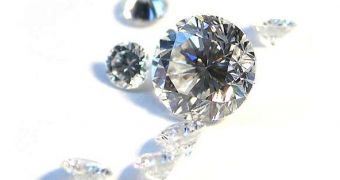A new method for producing artificial diamonds has been developed by the Geophysical Laboratory at the Carnegie Institution. Called chemical vapor deposition (CVD), it enables the science team to virtually grow the diamonds they need for their research from crystals. The process takes place at normal pressure and does not require stabilization, to prevent diamond turning into graphite.
Unlike all other diamond production processes, which attempt to recreate the condition inside the Earth's crust – that originally led to the formation of the diamonds – the new one simply grows a single crystal diamond very quickly, according to the specifications that have been "programmed" into the crystal beforehand. The final product has comparatively less defects than similarly-obtained diamonds and a more precise structure.
After the growth of the crystals is complete, the "early" diamonds are light brown, so they have to be stripped of their color. By using microwave plasma, directed towards the crystal at lower pressures than those around, Carnegie researchers were able to make them completely transparent, or just lightly pink-colored. This pigmentation occurred due to nitrogen-vacancy (NV) centers, which are structures where a nitrogen atom replaces a carbon one at a specific spot.
"It is striking to see brown CVD diamonds transformed by this cost-efficient method into clear, pink-tinted crystals. Our work may also help the gem industry to distinguish natural from synthetic diamond. The breakthrough will allow us to push to kilocarat diamonds of high optical quality," said Chih-shiue Yan and Ho-kwang Mao, both members of the science team that made this discovery.
Russell Hemley, the director of the Carnegie Institution laboratory, added "The optimized process will produce better diamond for new-generation high pressure devices and window materials with improved optical properties in the ultraviolet to infrared range. It has the advantage of being applicable in CVD reactors as a subsequent treatment after growth."

 14 DAY TRIAL //
14 DAY TRIAL //